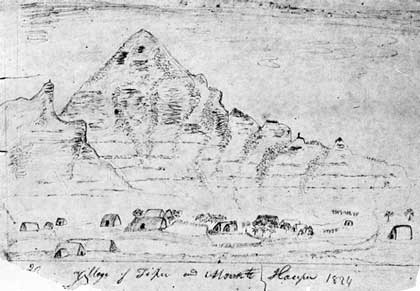|
|
|
Plantation:
Winds of Change
|
|
|
|
|
|
The first thing Cook saw when he approached the Hawaiian
Islands was Ha'upu. This drawing by William Ellis is the first
of Hawai'i by a European.
|
|
|
|
Winds of Change uses the wonderful
archival archaeology of Carol Silva's report in Archaeological
Investigation of Hule'ia National Wildlife Refuge Ha'iku,
Niumalu, Kaua'i to describe the history of Kaua'i from
Cook's arrival to the present time.
|
|
|
|
 |
|
The arrival of the Captain
Cook in 1778 began the end of the ahupua'a system of land management.
In their first encounter with the market economy, natives offered
Cook a feather cloak for one of his muskets(rifles). Cook considered
the musket to be much more valuable than the feather cloak,
one of the highest symbols of Hawaiian culture. After much bargaining,
the cloak was exchanged for one metal nail. (Kaua'i and the
Early Voyages) This deal set the tone for further native
trade with foreigners - natives would have trouble getting a
fair rate of exchange. |
|
|
Hawaiian Warrior by Herb Kane |
|
|
|
|
|
|
|
|
|
|
|
|
|
In exchange for fresh water and supplies,
Hawaiians received gonorrhea and syphilis from Cook's crew.
Within a year, these diseases spread throughout the island chain,
reducing population growth by causing female sterility. Other
diseases followed, and the Hawaiians, like the native plants
and animals that developed before their own arrival, had no
defense against the foreign imports. |
|
 |
|
|
|
|
|
|
|
photo by Dan Petr
|
|
|
 |
|
At Nawiliwili Bay before Cook's arrival,
the maka'ainana were enjoying a time of peace and prosperity
at the end of the Hawaiian Expansion Period. Kaua'i's isolation
from the other islands by the challenging (hard to cross) Ka
'ie 'ie Waho Channel had kept it from unnecessary conflict with
ambitious ali'i from other islands. Lands were maintained
in abundance, untouched by battle, and managed by Kaua'i chiefs
who had been appointed by Kamuali'i, ali'i nui of Kaua'i.
(Carol Silva) |
|
|
|
After Kamuali'i's death,
a rebellion occurred in 1825. This was quickly put down by chiefs
of Hawai'i and Maui, with a widespread redistribution of land
and resources to non-Kaua'i chiefs. One hypothesis for the uncommon
shapes of ahupua'a at Nawiliwili Bay is this redistribution.
It is also said these non-Kaua'i chiefs were often despised
by the native residents of Kaua'i. Fortunate were those maka'ainana,
those natives of the soil, whose rights were protected as power
passed out of Kaua'i hands. (Carol Silva) |
|
 |
|
|
|
|
Puna courtesy of Ho'okipa
Network |
|
|
|
|
|
|
|
|
|
|
|
 |
|
From 1825 - 1839, Kaua'i was governed
by Kaikio'ewa, who named Lihu'e after his home on O'ahu. He attracted
native planters to the area, giving twice as many land awards
as Kamuali'i' did. The choice lo'i were for the chiefs,
set aside for all residents to work upon one day out of the
week as their tax. (Carol Silva) Kaua'i's abundance allowed
a tax on men only, unlike the islands of Maui and Hawai'i, which
taxed both men and women. (Samuel Kamakau) |
|
When Kaikio'ewa came to your house
for dinner, he brought an entourage (group of attendants) of
200 people. (Joesting) |
|
|
|
|
|
|
|
|
|
|
|
Christian missionaries
arrived in the 1820's. When ali'i converted to this new
faith, it was the end of traditional Hawaiian customs and values.
Traditional beliefs were being replaced with concepts like credit.
Kamehameha III inherited the kingdom in 1824, along with close
to a $500,000 Hawaiian debt to the foreign traders. As the poor
rate of exchange continued, chiefs borrowed huge amounts of
money to pay for luxury items worth far less than what was paid.
|
|
 |
|
|
|
Above, Rev. Alexander preaches to the natives
at Ko'olau.
|
|
|
|
|
|
|
|
|
 |
|
The population of several hundred
thousand Hawaiians in 1778, fell to 88,000 by 1848. At Nawiliwili
Bay, analysis of skeletal remains indicates a large number of
the population died of syphilis and the flu influenza. The imposition
of a sandalwood tax throughout the Hawaiian Islands to pay off
ali'i debt made maka'ainana ignore their lo'i
to cut sandalwood. |
|
|
|
Because of the sandalwood tax, famine
plagued the maka'ainana during the reigns of Kamehameha
I, II, and III. On Kaua'i, the population of 10,000, in 1823,
became 6,941 by 1849. |
|
|
|
|
|
|
|
|
|
|
After their health and traditional
beliefs, what else did the maka'ainana have to
lose? In the mahele of 1848,
they lost access to the total land and water resources of their
ahupua'a. How did this happen? How did this affect Nawiliwili
Bay? |
|
|
|
|
|
|
|

